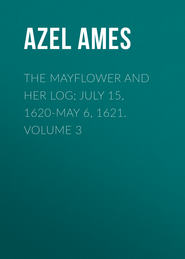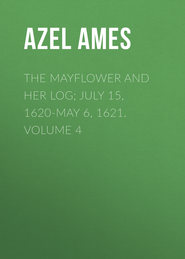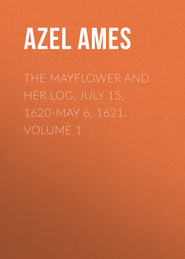По всем вопросам обращайтесь на: info@litportal.ru
(©) 2003-2024.
✖
The Mayflower and Her Log; July 15, 1620-May 6, 1621. Volume 5
Настройки чтения
Размер шрифта
Высота строк
Поля
The provisions in use, both by passengers and crew, were probably kept in the lazarette or "runs," in the stern of the ship, which would be unusually capacious in vessels of this model; some—the bulkiest—in the hold under the forward hatch, as the custom was, and to some extent still is. The food supply of the Pilgrims, constituting part of the MAY- FLOWER'S Cargo, included, as appears from authentic sources:—
Breadstuff's, including,—
Biscuits or ship-bread (in barrels).
Oatmeal (in barrels or hogsheads).
Rye meal (in hogsheads).
Butter (in firkins).
Cheese, "Hollands" and English (in boxes).
Eggs, pickled (in tubs).
Fish, "haberdyne" [or salt dried cod] (in boxes).
Smoked herring (in boxes).
Meats, including,—
Beef, salt, or "corned" (in barrels).
Dry-salted (in barrels).
Smoked (in sacks).
Dried neats'-tongues (in boxes).
Pork, bacon, smoked (in sacks or boxes).
Salt [" corned "] (in barrels).
Hams and shoulders, smoked (in canvas sacks or hogsheads).
Salt (in bags and barrels).
Vegetables, including,—
Beans (in bags and barrels).
Cabbages (in sacks and barrels).
Onions (in sacks).
Turnips (in sacks).
Parsnips (in sacks).
Pease (in barrels), and
Vinegar (in hogsheads), while,—
Beer (in casks), brandy, "aqua vitae" (in pipes), and gin ["Hollands,"
"strong waters," or "schnapps"] (in pipes) were no small or unimportant part, from any point of view, of the provision supply.
Winslow, in his letter to George Morton advising him as to his preparations for the voyage over, says: "Be careful to have a very good bread-room to keep your biscuit in." This was to keep them from dampness. Winthrop gives us the memorandum of his order for the ship- bread for his voyage in 1630. He says: "Agreed with Keene of Southwark, baker, for 20,000 of Biscuit, 15,000 of brown, and 5,000 of white." Captain Beecher minutes: "10 M. of bread for the ship ARBELLA." Beecher's memorandum of "oatmeal" is "30 bushels." Winslow mentions "oatmeal," and Winthrop notes among the provisions bought by Captain William Pierce, "4 hhds. of oatmeal." Rye meal was usually meant by the term "meal," and Window in his letter to George Morton advises him: "Let your meal be so hard-trod in your casks that you shall need an adz or hatchet to work it out with;" and also to "be careful to come by [be able to get at] some of your meal to spend [use] by the way." Notwithstanding that Bradford' speaks of their "selling away" some "60 firkins of butter," to clear port charges at Southampton, and the leaders, in their letter to the Adventurers from that port (August 3), speak of themselves, when leaving Southampton in August, 1620, as "scarce having any butter," there seems to have been some left to give as a present to Quadrequina, Massasoit's brother, the last of March following, which would indicate its good "keeping" qualities. Wood, in his "New England's Prospect" (ch. 2), says: "Their butter and cheese were corrupted." Bradford mentions that their lunch on the exploration expedition of November 15, on Cape Cod, included "Hollands cheese," which receives also other mention. There is a single mention, in the literature of the day, of eggs preserved in salt, for use on shipboard. "Haberdyne" (or dried salt cod) seems to have been a favorite and staple article of diet aboard ship. Captain Beecher minutes "600 haberdyne for the ship ARBELLA." Wood says: "Their fish was rotten." Smoked "red-herring" were familiar food to all the MAY-FLOWER company. No house or ship of England or Holland in that day but made great dependence upon them. Bacon was, of course, a main staple at sea. In its half-cooked state as it came from the smoke-house it was much relished with their biscuit by seamen and others wishing strong food, and when fried it became a desirable article of food to all except the sick. Mention is made of it by several of the early Pilgrim writers. Carlyle, as quoted, speaks of it as a diet-staple on the MAY-FLOWER. Salt ("corned") beef has always been a main article of food with seamen everywhere. Wood' states that the "beef" of the Pilgrims was "tainted." In some way it was made the basis of a reputedly palatable preparation called "spiced beef," mentioned as prepared by one of the sailors for a shipmate dying on the MAY-FLOWER in Plymouth harbor. It must have been a very different article from that we now find so acceptable under that name in England. Winthrop' gives the price of his beef at "19 shillings per cwt." Winslow advises his friend Morton, in the letter so often quoted, not to have his beef "dry-salted," saying, "none can do it better than the sailors," which is a suggestion not readily understood. "Smoked" beef was practically the same as that known as "jerked," "smoked," or "dried" beef in America. A "dried neat's- tongue" is named as a contribution of the Pilgrims to the dinner for Captain Jones and his men on February 21, 1621, when they had helped to draw up and mount the cannon upon the platform on the hill at Plymouth. Winthrop paid "14d. a piece" for his "neats' tongues." The pork of the Pilgrims is also said by Wood' to have been "tainted." Winthrop states that his pork cost "20 pence the stone" (14 lbs.).
Hams seem to have been then, as now, a highly-prized article of diet.
Goodwin mentions that the salt used by the Pilgrims was (evaporated) "sea-salt" and very "impure." Winthrop mentions among his supplies,
"White, Spanish, and Bay salt."
The beans of the Pilgrims were probably of the variety then known as "Spanish beans." The cabbages were apparently boiled with meat, as nowadays, and also used considerably for "sour-krout" and for pickling, with which the Leyden people had doubtless become familiar during their residence among the Dutch. As anti-scorbutics they were of much value. The same was true of onions, whether pickled, salted, raw, or boiled. Turnips and parsnips find frequent mention in the early literature of the first settlers, and were among their stock vegetables. Pease were evidently staple articles of food with the Plymouth people, and are frequently named. They probably were chiefly used for porridge and puddings, and were used in large quantities, both afloat and ashore.
Vinegar in hogsheads was named on the food-list of every ship of the Pilgrim era. It was one of their best antiscorbutics, and was of course a prime factor in their use of "sour krout," pickling, etc. The fruits, natural, dried, and preserved, were probably, in that day, in rather small supply. Apples, limes, lemons, prunes, olives, rice, etc., were among the luxuries of a voyage, while dried or preserved fruits and small fruits were not yet in common use. Winslow, in the letter cited, urges that "your casks for beer . . . be iron bound, at least for the first [end] tyre" [hoop]. Cushman states that they had ample supplies of beer offered them both in Kent and Amsterdam. The planters' supply seems to have failed, however, soon after the company landed, and they were obliged to rely upon the whim of the Captain of the MAY-FLOWER for their needs, the ship's supply being apparently separate from that of the planters, and lasting longer. Winthrop's supply seems to have been large ("42 tons"—probably tuns intended). It was evidently a stipulation of the charter-party that the ship should, in part at least, provision her crew for the voyage,—certainly furnish their beer. This is rendered certain by Bradford's difficulty (as stated by himself) with Captain Jones, previously referred to, showing that the ship had her own supply of beer, separate from that of the colonists, and that it was intended for the seamen as well as the officers.
Bradford mentions "aqua vitae" as a constituent of their lunch on the exploring party of November 15. "Strong waters" (or Holland gin) are mentioned as a part of the entertainment given Massasoit on his first visit, and they find frequent mention otherwise. Wine finds no mention. Bradford states in terms: "Neither ever had they any supply of foode from them [the Adventurers] but what they first brought with them;" and again, "They never had any supply of vitales more afterwards (but what the Lord gave them otherwise), for all ye company [the Adventurers] sent at any time was allways too short for those people yt came with it."
The clothing supplies of the Pilgrims included hats, caps, shirts, neck- cloths, jerkins, doublets, waistcoats, breeches (stuff and leather), "hosen," stockings, shoes, boots, belts (girdles), cloth, piece-goods (dress-stuff's), "haberdasherie," etc., etc., all of which, with minor items for men's and women's use, find mention in their early narratives, accounts, and correspondence. By the will of Mr. Mullens it appears that he had twenty-one dozen of shoes and thirteen pairs of boots on board, doubtless intended as medium of exchange or barter. By the terms of the. contract with the colonists, the Merchant Adventurers were to supply all their actual necessities of Clothing food, clothing, etc., for the full term of seven years, during which the labors of the "planters" were to be for the joint account. Whether under this agreement they were bound to fully "outfit" the colonists before they embarked (and did so), as was done by Higginson's company coming to Salem in 1628-29 at considerable cost per capita, and as was done for those of the Leyden people who came over in 1629 with Pierce in the MAY-FLOWER and the TALBOT to Salem, and again in 1630 with the same Master (Pierce) in the LION by the Plymouth successors to the Adventurers (without recompense), does not clearly appear. No mention is found of any "outfitting" of the MAY-FLOWER passengers except the London apprentices. There is no doubt that a considerable supply of all the above-named articles was necessarily sent by the Adventurers on the MAY-FLOWER, both for the Pilgrims' needs on the voyage and in the new colony, as also for trading purposes. There seems to have been at all times a supreme anxiety, on the part of both Pilgrim and Puritan settlers, to get English clothes upon their red brethren of the forest, whether as a means of exchange for peltry, or for decency's sake, is not quite clear. There was apparently a greater disparity in character, intelligence, and station between the leaders of Higginson's and Winthrop's companies and their followers than between the chief men of the Pilgrims and their associates. With the former were titles and considerable representation of wealth and position. With the passengers of the MAY-FLOWER a far greater equality in rank, means, intelligence, capacity, and character was noticeable. This was due in part, doubtless, to the religious beliefs and training of the Leyden contingent, and had prompt illustration in their Compact, in which all stood at once on an equal footing. There was but little of the "paternal" nature in the form of their government (though something at times in their punishments), and there was much personal dignity and independence of the indi vidual. An equipment having so much of the character of a uniform—not to say "livery "—as that furnished by Higginson's company to its people suggests the "hedger and ditcher" type of colonists (of whom there were very few among the Plymouth settlers), rather than the scholar, publisher, tradesman, physician, hatter, smith, carpenter, "lay reader," and soldier of the Pilgrims, and would certainly have been obnoxious to their finer sense of personal dignity and proportion. Doubtless an equivalent provision existed—though in less "all-of-a-pattern " character—in the bales and boxes of the MAY-FLOWER'S cargo for every need suggested by the list of the Higginson "outfit," which is given herewith, both as matter of interest and as affording an excellent idea of the accepted style and needs in dress of a New England settler (at least of the men) of 1620-30. One cannot fail to wonder at the noticeably infrequent mention of provision in apparel, etc., for the women and children. The inventory of the "Apparell for 100 men" furnished by Higginson's company in 1628-29 gives us, among others, the following items of clothing for each emigrant:– 4 "peares of shoes." 4 "peares of stockings." 1 "peare Norwich gaiters." 4 "shirts." 2 "suits dublet and hose of leather lyn'd with oyld skyn leather, ye hose & dublett with hooks & eyes." 1 "sute of Norden dussens or hampshire kersies lynd the hose with skins, dublets with lynen of gilford or gedlyman kerseys." 4 bands. 2 handkerchiefs. 1 "wastecoat of greene cotton bound about with red tape." 1 leather girdle. 1 "Monmouth cap." 1 "black hatt lyned in the brows with lether." 5 "Red knitt capps milf'd about 5d apiece." 2 "peares of gloves." 1 "Mandiliion lynd with cotton" [mantle or greatcoat]. 1 "peare of breeches and waistcoat." 1 "leather sute of Dublett & breeches of oyled leather." 1 "peare of leather breeches and drawers to weare with both there other sutes."
In 1628 Josselyn put the average cost of clothing to emigrants to New
England at L4 each. In 1629 good shoes cost the "Bay" colonists 2s/7d
per pair. In his "Two Voyages to New England "previously referred to,
Josselyn gives an estimate (made about 1628) of the "outfit" in clothing
needed by a New England settler of his time. He names as "Apparel for
one man—and after this rate for more:—"
One Hatt
One Monmouth Cap
Three falling bands
Three Shirts
One Wastcoat
One Suite of Frize (Frieze)
One Suite of Cloth









